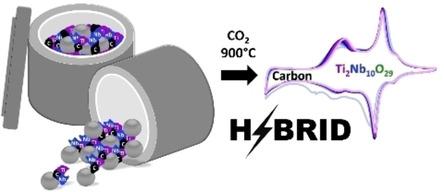当前位置:
X-MOL 学术
›
ChemSusChem
›
论文详情
Our official English website, www.x-mol.net, welcomes your feedback! (Note: you will need to create a separate account there.)
Titanium Niobium Oxide Ti2Nb10O29/Carbon Hybrid Electrodes Derived by Mechanochemically Synthesized Carbide for High‐Performance Lithium‐Ion Batteries
ChemSusChem ( IF 8.4 ) Pub Date : 2020-10-30 , DOI: 10.1002/cssc.202002229 Öznil Budak 1, 2 , Pattarachai Srimuk 1 , Mesut Aslan 1 , Hwirim Shim 1, 2 , Lars Borchardt 3 , Volker Presser 1, 2
ChemSusChem ( IF 8.4 ) Pub Date : 2020-10-30 , DOI: 10.1002/cssc.202002229 Öznil Budak 1, 2 , Pattarachai Srimuk 1 , Mesut Aslan 1 , Hwirim Shim 1, 2 , Lars Borchardt 3 , Volker Presser 1, 2
Affiliation

|
This work introduces the facile and scalable two‐step synthesis of Ti2Nb10O29 (TNO)/carbon hybrid material as a promising anode for lithium‐ion batteries (LIBs). The first step consisted of a mechanically induced self‐sustaining reaction via ball‐milling at room temperature to produce titanium niobium carbide with a Ti and Nb stoichiometric ratio of 1 to 5. The second step involved the oxidation of as‐synthesized titanium niobium carbide to produce TNO. Synthetic air yielded fully oxidized TNO, while annealing in CO2 resulted in TNO/carbon hybrids. The electrochemical performance for the hybrid and non‐hybrid electrodes was surveyed in a narrow potential window (1.0–2.5 V vs. Li/Li+) and a large potential window (0.05–2.5 V vs. Li/Li+). The best hybrid material displayed a specific capacity of 350 mAh g−1 at a rate of 0.01 A g−1 (144 mAh g−1 at 1 A g−1) in the large potential window regime. The electrochemical performance of hybrid materials was superior compared to non‐hybrid materials for operation within the large potential window. Due to the advantage of carbon in hybrid material, the rate handling was faster than that of the non‐hybrid one. The hybrid materials displayed robust cycling stability and maintained ca. 70 % of their initial capacities after 500 cycles. In contrast, only ca. 26 % of the initial capacity was maintained after the first 40 cycles for non‐hybrid materials. We also applied our hybrid material as an anode in a full‐cell lithium‐ion battery by coupling it with commercial LiMn2O4.
中文翻译:

用于高性能锂离子电池的机械化学合成碳化物衍生的钛铌氧化物 Ti2Nb10O29/碳混合电极
这项工作介绍了 Ti 2 Nb 10 O 29 (TNO)/碳混合材料作为锂离子电池 (LIBs) 负极的简便且可扩展的两步合成方法。第一步包括在室温下通过球磨进行机械诱导的自持反应,以生产 Ti 和 Nb 化学计量比为 1 比 5 的碳化钛铌。第二步涉及将合成的碳化钛铌氧化为生产 TNO。合成空气产生完全氧化的 TNO,而在 CO 2中退火产生 TNO/碳杂化物。混合和非混合电极的电化学性能在一个狭窄的电位窗口(1.0-2.5 V vs. Li/Li +) 和大的电位窗口 (0.05–2.5 V vs. Li/Li + )。最好的混合材料在 0.01 A g -1的速率下显示出 350 mAh g -1的比容量(144 mAh g -1 at 1 A g -1) 在大势窗口区域。与非混合材料相比,混合材料的电化学性能优于在大电位窗口内运行的非混合材料。由于碳在混合材料中的优势,速率处理比非混合材料更快。混合材料显示出强大的循环稳定性并保持约。500 次循环后达到初始容量的 70%。相比之下,只有约。对于非混合材料,在前 40 个循环后保持 26% 的初始容量。我们还通过将我们的混合材料与商用 LiMn 2 O 4耦合,将其用作全电池锂离子电池的阳极。
更新日期:2021-01-08
中文翻译:

用于高性能锂离子电池的机械化学合成碳化物衍生的钛铌氧化物 Ti2Nb10O29/碳混合电极
这项工作介绍了 Ti 2 Nb 10 O 29 (TNO)/碳混合材料作为锂离子电池 (LIBs) 负极的简便且可扩展的两步合成方法。第一步包括在室温下通过球磨进行机械诱导的自持反应,以生产 Ti 和 Nb 化学计量比为 1 比 5 的碳化钛铌。第二步涉及将合成的碳化钛铌氧化为生产 TNO。合成空气产生完全氧化的 TNO,而在 CO 2中退火产生 TNO/碳杂化物。混合和非混合电极的电化学性能在一个狭窄的电位窗口(1.0-2.5 V vs. Li/Li +) 和大的电位窗口 (0.05–2.5 V vs. Li/Li + )。最好的混合材料在 0.01 A g -1的速率下显示出 350 mAh g -1的比容量(144 mAh g -1 at 1 A g -1) 在大势窗口区域。与非混合材料相比,混合材料的电化学性能优于在大电位窗口内运行的非混合材料。由于碳在混合材料中的优势,速率处理比非混合材料更快。混合材料显示出强大的循环稳定性并保持约。500 次循环后达到初始容量的 70%。相比之下,只有约。对于非混合材料,在前 40 个循环后保持 26% 的初始容量。我们还通过将我们的混合材料与商用 LiMn 2 O 4耦合,将其用作全电池锂离子电池的阳极。



























 京公网安备 11010802027423号
京公网安备 11010802027423号